
Yoshi Touch and Go
More of an endless-walker than an endless-runner, Yoshi's perpetual march is one of the earliest, and best, examples of the genre
Yoshi Touch and Go
Platform: Nintendo DS

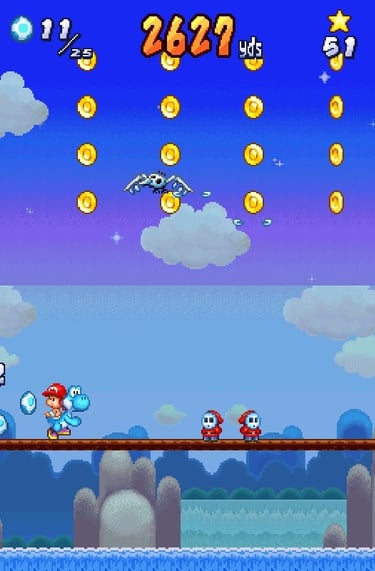
The 1990s proved a difficult time for Super Mario fans, especially those who preferred the plumber’s 2-D outings. After 1992’s Super Mario Land 2, fans wouldn’t receive a brand-new side-scrolling adventure until New Super Mario Bros. graced the handheld DS in 2006. But all wasn’t lost; several new contenders emerged from the hero’s shadow to provide their own unique take on the 2-D platformer. The Wario Land series swapped speed and tricky jumping for a more methodical, exploration-heavy approach. And Yoshi, once sidelined as Mario’s sidekick, began starring in his own franchise of games, most notably Yoshi’s Island and Yoshi’s Story.
Then came the Nintendo DS, a dual-screened, touch-based system released in late 2004. Lacking a proper Mario game to help advertise the system and its, at the time, novel features, the company chose the dino as its go-to host. Debuting in early 2005, Yoshi Touch and Go showed just what Nintendo’s unproven handheld could do…at least to the modest few that bothered to play it.
And it’s not a surprise why—Touch and Go is essentially an endless runner born just before the then-nascent genre had really been defined. Indeed, a half decade later, the category would find glory on the iPhone and countless other touch devices courtesy of their easily-accessed on-line marketplaces filled with cheap, simple games. Temple Run, Jetpack Joyride, Banana Kong—even Super Mario Run—would all become staples of the easy-to-play, easy-to-lose genre. But in 2005, the notion of playing with one’s fingers, or stylus, hadn’t yet been normalized as a valid, mainstream option of control.
So Yoshi Touch and Go appeared not only as a nifty demonstration of the DS’ capabilities, it also served, for many, as an introduction into a new genre—one where “winning” simply meant beating one’s former high score. Where the goal was progressing farther than before. And here, the game succeeds—it’s not a great “Yoshi Game” in the conventional sense, but it’s an auto-runner about as good as anything that would later follow.
The game’s story, of course, is really just a premise: as in the original Yoshi’s Island, Baby Mario becomes but the baton in a chain of Yoshies trekking him back to his incompetent stork. The difference is in the ending; the original game had one, this one doesn’t. Touch and Go doesn’t conclude until Yoshi falls to foe or hole.
And that’s really the gist of the experience. Yoshi must be guided through a gauntlet of endless dangers, overcoming piranha plants and dive-bombing shy guys to monkeys flinging spiny seeds from the trees. Spikes are everywhere, holes are numerous, and ammo is limited—by tapping the screen, players can impel Yoshi to toss one of a modest supply of eggs at the impending danger. Gobbling fruit replenishes these munitions…but players who aren’t careful will find themselves running short, rather fast.
More interesting, perhaps, are the secondary touch-screen mechanics. Tapping the dino directly will cause him to leap, and drawing on the screen creates a line of tiny clouds that can both serve as bridges over hazards and barriers against incoming baddies. Blowing into the system’s microphone eliminates the clouds, while swerving a circle over items and enemies alike traps them into a snatchable bubble. The mechanics are nothing brilliant by themselves, but when tethered together, they offer a fun, dynamic experience.
But that experience is a thin one, even by 2005 standards. Those attracted to the brightly-styled graphics and cute tunes done in the Yoshi’s Island-manner were disappointed by the game’s simplistic nature. And others, after paying the $30-40 dollars price tag, felt a little duped. Maybe these folks missed the point—that this was an arcade-like game more about chasing points than an epic story. But it also raised concerns whether the DS’ dual-screen, touch-based concept was too gimmicky to deliver substantive experiences.
This fear would be ultimately dispelled, but that wouldn’t save Yoshi's odd spin-off from becoming anything but a passing reference in the long annals of Nintendo history. Even within the Yoshi canon, it’s barely a footnote...despite being a fun distraction and, to this day, one of the genre’s best endless runners.
Which begs the question: Instead of Super Mario Run, why didn’t the Big N adapt Yoshi to the mobile market? It seems the perfect fit for the smartphone/tablet driven world. But the closest the game ever got was a rerelease on the Nintendo Wii U, a console that, like the game, didn’t get much respect…the two soon doomed to obscurity.
Yoshi Touch and Go will never been more than an addictive time waster. But not all games need to be epic or self-important. Some can be simple, incidental, low-key, and a little weird. This is a game that excels in all the “wrong” ways, and for that, it deserves to be played.
Even if just for a bit.--D
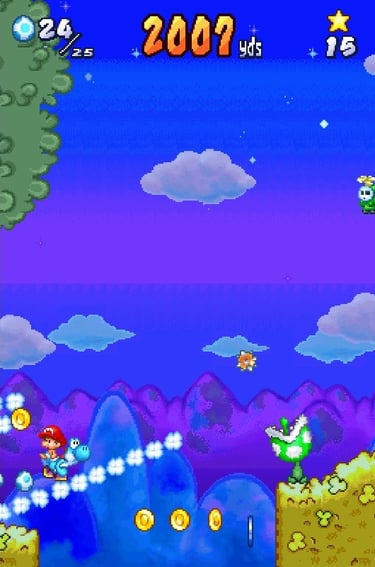

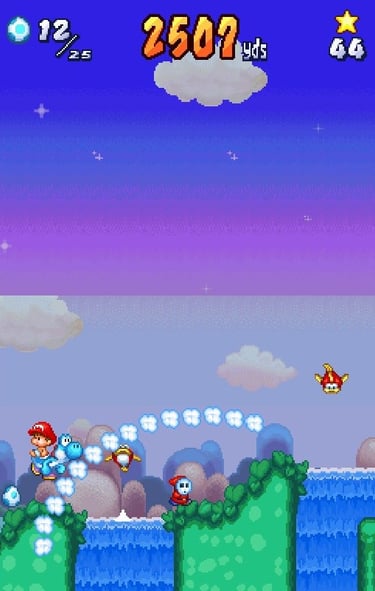


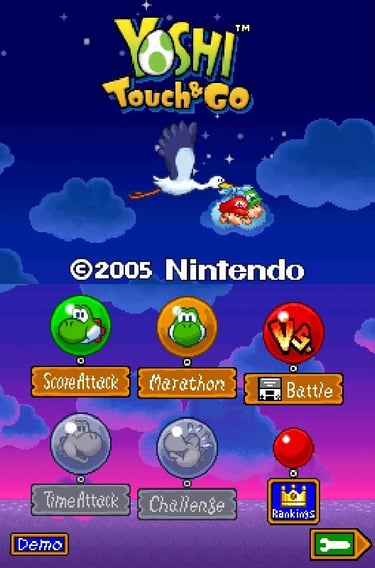

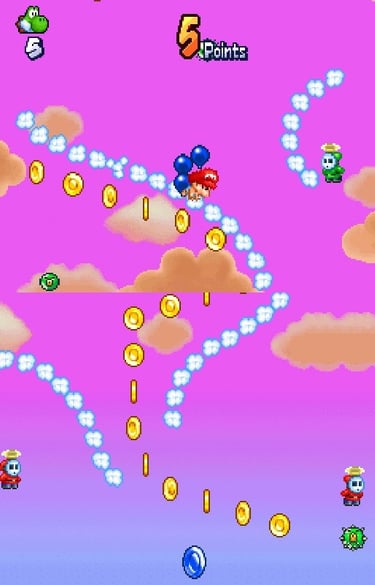
Publisher: Nintendo
Developer: Nintendo EAD
Release: 2005
Genre: Platformer
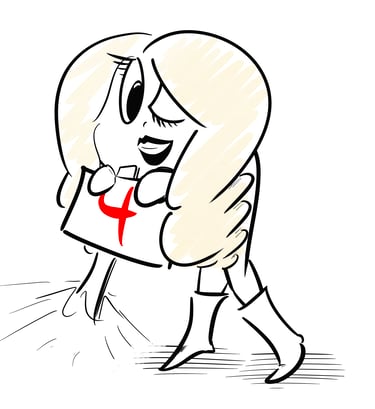

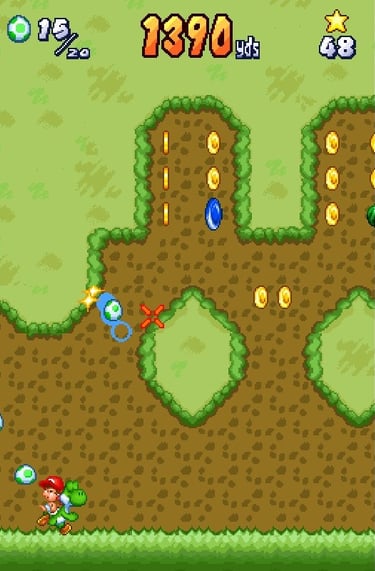

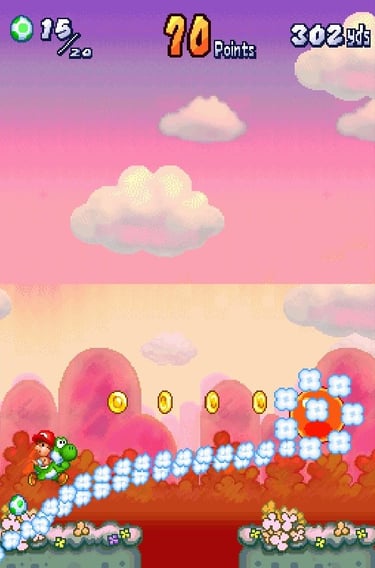

The game is impossible without learning the art of drawing cloud walkways. They make nice bridges, yes, but also serve to block enemies--from flying shy guys to jumping fish.
The game features several modes of play, including an interesting battle mode. "Marathon," however, is the closest the game comes to being a Yoshi-styled adventure.
The game's environments are varied and sometimes juxtapose weird elements...like these creepy, skeletal gulls flying over an otherwise serene, sunny day.
"Marathon" and "Score Attack" modes begin with a brief opening sequence in which players must help Baby Mario land safely to the Yoshi below.
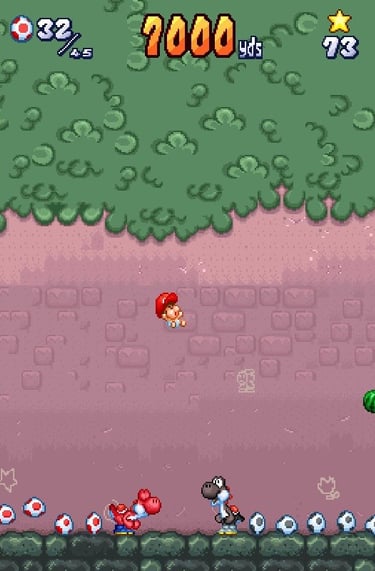

Vague "bonus" areas appear every 500yds or so; a well-aimed egg can often net plenty of coins and egg-refilling fruit. At every 1000-yard mark, Baby Mario is tossed to the next Yoshi in the sequence.
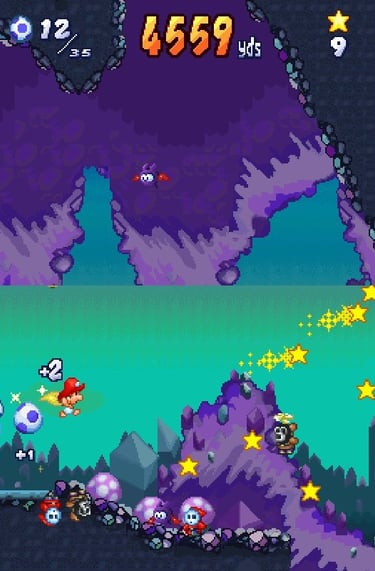


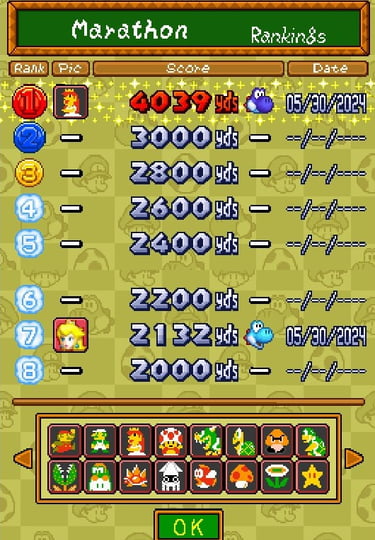
Coins are important: every 100 collected yields an invincibility star that allows Mario to take center stage...if just for a brief moment.
Upon inevitable defeat, the player's yardage--the game's equivalent to score--is recorded along with a cutesy icon. Sadly, no Wi-Fi, global support.
A deft wind of the stylus can trap baddies into helpless bubbles, and ensnare goodies into sweet deliveries.
Contact: lostnostalgiaproductions@gmail.com
Website: www.lostnostalgia.com
Like what we're doing? Please consider throwing us a dollar into our Patreon page's tip jar!


